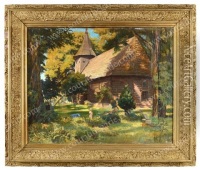Mikhail Ivanovich Lebedev Paintings
Mikhail Ivanovich Lebedev was a Russian artist known for his landscape paintings, born on October 2, 1811, in Saint Petersburg, Russia. He was part of the early 19th-century Romantic movement in Russian art, which emphasized emotion and a glorification of the past and nature, diverging from the neoclassical style that was prevalent in the early 1800s.
Lebedev's initial artistic training began at the Imperial Academy of Arts in Saint Petersburg, where he studied from 1820 to 1830. During his time at the Academy, he was awarded several medals for his work, which allowed him to continue his studies abroad – a common practice for talented young artists of the period. In 1830, he left for Italy, which had a profound impact on his artistic development. The Italian landscape, rich with historical ruins and bathed in a unique quality of light, became a central theme in his work.
Throughout the 1830s, Lebedev traveled within Italy, painting various regions from Rome to the Campagna, and further south to Naples and its surroundings. His work was characterized by a keen observation of natural light and atmosphere, capturing the lushness of the Italian countryside and the historical grandeur of its ruins. He was particularly adept at using watercolors, a medium that allowed him to quickly and effectively capture the changing moods of the landscapes he loved.
Unfortunately, Lebedev's life was cut short when he died of cholera on July 12, 1837, in Rome, Italy, at the young age of 25. Despite his brief career, he left behind a body of work that had a lasting influence on Russian landscape painting. His innovative approach to interpreting light and atmosphere would inspire future generations of Russian artists. The works of Mikhail Ivanovich Lebedev are now preserved in various museums, with a significant collection in the Russian Museum in Saint Petersburg, ensuring that his artistic legacy continues to be appreciated.

